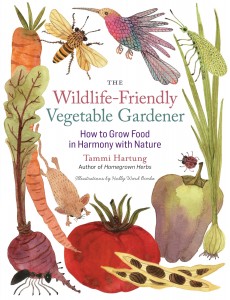 I will never develop the equanimity that Tammi Hartung has towards rodents, rabbits and raccoons, but I admire her dedication to working with nature, respecting natural cycles and accommodating creatures that will pretty much take what they want anyway. And, her new book on vegetable and wildlife gardening has me thinking about new strategies for keeping the critters — and the gardener — happy. If you enjoy wildlife and you enjoy the fruits of your vegetable garden, it’s well worth reading.
I will never develop the equanimity that Tammi Hartung has towards rodents, rabbits and raccoons, but I admire her dedication to working with nature, respecting natural cycles and accommodating creatures that will pretty much take what they want anyway. And, her new book on vegetable and wildlife gardening has me thinking about new strategies for keeping the critters — and the gardener — happy. If you enjoy wildlife and you enjoy the fruits of your vegetable garden, it’s well worth reading.
The Wildlife-Friendly Vegetable Gardener: How to Grow Food in Harmony with Nature (Storey Publishing, 2014) offers gardeners a philosophy toward wildlife and a variety of methods for giving creatures what they want while still growing enough food for yourself. Hartung, a medical herbalist and organic grower from Colorado, encourages gardeners to begin with careful observation of wildlife and their interaction with your garden. Sit with a cup of coffee or a glass of wine some day and watch what’s happening in your yard. That squirrel you see running about may be burying an acorn, not attacking your green beans, she says. Knowing which creatures frequent your yard, how they interact with each other and what their needs are will help gardeners determine whether action is really needed to curtail their activities.
She gives the example of the tomato hornworm — a creature I’m very familiar with. Large, green and spiky, they look nasty. And, tomato hornworms can indeed defoliate a tomato plant in short order, Hartung says. But their lifecycle is short — 20 days for the caterpillar stage — and the sphinx moths that they morph into are masterful pollinators, as well as stunning garden visitors. Tomato hornworms also are food for parasitic wasps, which may handle hornworm removal for you. So, your better approach might be to tolerate and appreciate rather than destroy. Or, do as one gardener does and plant one tomato just for the hornworms. When hornworms are present, move them over to the designated plant and they will leave the rest of your plants alone, she says. This is the essence of being a wildlife-friendly vegetable gardener.
Hartung’s suggestions of decoy plants to keep critters at bay are particularly useful. Rabbits are my main garden “helpers.” Last year, I added fencing around a vegetable area to get them to back off, but this year I will supplement that with ample plantings of parsley outside of the fence (which they sometimes managed to get into) as well as calendulas to lure aphids from plants I enjoy. Sunflowers will be added to my wild area to bring even more birds into the garden.
If you want to attract wildlife to your garden, this book offers plenty of concrete suggestions, including ways to create habitat for birds, frogs and other creatures, add water features, use hedgerows to provide nesting sites and perennial food sources. Some of her suggestions will be familiar to those already practicing wildlife-friendly gardening, but Hartung fleshes out many suggestions with details on plants and placement. The book also includes plant lists and garden designs for bee-friendly landscapes among others.
One of the highlights of the book are the illustrations by Holly Ward Bimba, which are whimsical and as friendly as the gardens Hartung advocates.
I will have to add this book to my collection.
I have just started reading this book and it definitely has lots of good advice for living with the wildlife in your garden – even when you don’t have to go to any special trouble to invite them in.